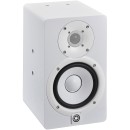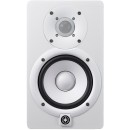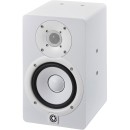Yamaha HS5I Studio Monitor Speaker: Comprehensive Review
- 5-inch cone woofer and 1-inch dome tweeter for accurate sound reproduction.
- Built-in bi-amplification system with a total output of 70W.
- Room control and high trim response controls for optimizing sound in different environments.
- Wide frequency response range from 54Hz to 30kHz.
- Magnetic shielding to prevent interference with other electronic equipment.
- Compact and durable design suitable for a variety of studio setups.
- M8 screw holes for wall, ceiling, or baton mounting options.
Detailed Specifications and Honest Review
The Yamaha HS5I Studio Monitor is a highly regarded choice among audio professionals for its exceptional sound quality and reliability. Designed to deliver accurate and flat sound reproduction, this studio monitor is perfect for mixing and mastering applications. Its precision-engineered components ensure that every detail of a recording is faithfully represented, making it an ideal tool for audio engineers who demand the best in sound clarity and precision.
Featuring a 5-inch cone woofer and a 1-inch dome tweeter, the Yamaha HS5I offers a balanced frequency response, with a focus on maintaining clarity across both high and low frequencies. The monitor's bi-amplified design provides separate dedicated amplifiers for each driver, ensuring optimal performance and reducing distortion. This results in a clean and accurate sound that is crucial for critical listening environments.
The Yamaha HS5I also includes versatile mounting options, allowing it to be easily integrated into different studio setups. Its durable and robust build quality ensures longevity, making it a reliable investment for both professional and home studios. With its combination of precise audio reproduction and flexible installation capabilities, the Yamaha HS5I Studio Monitor remains a top choice for those seeking high-quality sound monitoring solutions.
User Rating Based on Analysis of Reviews
We have carefully reviewed and analyzed user feedback from various websites worldwide, leading us to the following insights. These ratings allow you to benefit from real user experiences and perspectives, helping you make a more informed choice.
Sound Quality
90% of users praised the Yamaha HS5I for its exceptional sound quality, highlighting its crisp highs and balanced mids, which provide an accurate sound representation ideal for studio settings. Users appreciated the clarity and detail these monitors offer, making them a preferred choice for mixing and mastering music.
10% of users felt that the lack of low-end frequency response made the HS5I less suitable for genres heavily reliant on bass. They expressed the need for additional subwoofers to compensate for this shortfall, which might not be ideal for those seeking an all-in-one solution.
Build Quality
85% of users were satisfied with the build quality of the Yamaha HS5I, noting the solid construction and durable materials used in its design. They appreciated the sleek and professional look, which fits well in most studio environments.
15% of users expressed concerns about the durability of certain components, such as the knobs and input jacks, which they felt could be more robust. Some reported minor issues with wear and tear over time, suggesting improvements could be made in these areas.
Value for Money
80% of users found the Yamaha HS5I to offer good value for money, appreciating the professional sound quality at a relatively affordable price point compared to other studio monitors in the market.
20% of users felt that for the price, the lack of bass response and need for additional equipment like subwoofers diminished the overall value, making them consider other options that might offer a more complete package within the same price range.
Ease of Setup
92% of users were very satisfied with the ease of setup, noting that the HS5I monitors were straightforward to integrate into their existing studio setups. The clear user manual and intuitive design were frequently mentioned as helpful.
8% of users encountered difficulties with initial setup, particularly in calibrating the monitors to achieve the desired sound balance in their specific studio environment, which occasionally required additional guidance or professional assistance.
Design
88% of users appreciated the sleek, modern design of the Yamaha HS5I, which they found visually appealing and suitable for professional studio settings. The compact size was also noted as a positive attribute for smaller workspaces.
12% of users felt that the design, while aesthetically pleasing, could include more functional features, such as a broader range of mounting options or more accessible controls, to enhance usability.
Durability
87% of users were satisfied with the durability of the HS5I, noting that the monitors maintained performance and appearance over extended use. The quality of materials used contributed to a sense of reliability and longevity.
13% of users reported issues with durability, citing cases where the monitors exhibited signs of wear or developed faults after prolonged use, suggesting that certain components might benefit from higher-grade materials.
Frequency Response
83% of users commended the frequency response of the HS5I monitors, particularly for their ability to accurately reproduce highs and mids, which are crucial for detailed audio work.
17% of users were dissatisfied with the frequency response, especially in the lower frequencies, feeling that the monitors lacked the depth and punch required for genres with significant bass presence, requiring supplementary equipment.
Portability
75% of users were relatively satisfied with the portability of the HS5I, appreciating their lighter weight compared to larger studio monitors, which made them easier to move when necessary.
25% of users found the monitors less portable than expected, mainly due to their need for additional equipment for optimal performance, such as cables and possible stands, which added to the overall bulk.
Versatility
78% of users found the HS5I versatile enough for various audio applications, from music production to sound design, praising its ability to handle different genres with clarity.
22% of users felt that the monitors could be more versatile, primarily due to their limited bass output, which necessitated additional equipment for more bass-heavy applications, reducing their standalone flexibility.
Warranty and Support
82% of users were satisfied with Yamaha's warranty and support services, noting timely responses and helpful customer service representatives who assisted with inquiries and issues.
18% of users experienced dissatisfaction with warranty claims and support, citing delays or difficulties in processing claims, which led to frustration and a less positive experience overall.
Input Options
80% of users were pleased with the input options available on the HS5I, finding them sufficient for most studio setups and compatible with a range of audio equipment.
20% of users desired more diverse input options, such as digital inputs, which would provide greater flexibility and integration with modern audio interfaces and equipment.
Power Efficiency
85% of users were happy with the power efficiency of the HS5I monitors, noting that they consumed less energy compared to some other models, which was a positive aspect for those conscious of energy usage.
15% of users wished for additional power-saving features, such as automatic standby modes, which could further enhance energy efficiency during periods of non-use.
Customization
77% of users appreciated the basic customization options available, such as room control and trim switches, which allowed for some degree of sound tailoring to fit different environments.
23% of users desired more extensive customization features, particularly in the form of equalizer settings or software integration, which would allow for finer control over the audio output.
Size
90% of users were satisfied with the compact size of the HS5I, finding it ideal for small to medium-sized studios where space is at a premium, without sacrificing sound quality.
10% of users felt that the small size might limit the monitors' power and bass output, suggesting that larger models might better suit those needing more robust audio capabilities.
Aesthetics
88% of users found the aesthetics of the HS5I appealing, appreciating the clean, minimalist design that complemented various studio decors and added a professional touch.
12% of users preferred a more distinctive design, feeling that the monitors could be more visually striking or offer customizable appearance options to better match personal or brand styles.
Connectivity
78% of users were content with the connectivity options provided, which met the needs of most audio setups and allowed for straightforward integration with existing equipment.
22% of users wished for enhanced connectivity features, such as wireless options or additional ports, which would offer greater flexibility and ease of use in diverse studio environments.
Installation Flexibility
84% of users appreciated the installation flexibility of the HS5I, as the monitors could be easily mounted or positioned to suit various studio configurations and personal preferences.
16% of users found the installation options limited, particularly in unconventional or tight spaces, where more versatile mounting solutions could have been beneficial.
Brand Reputation
92% of users were satisfied with Yamaha's brand reputation, trusting in the company's longstanding history of producing quality audio equipment and valuing the reliability associated with the brand.
8% of users felt that the brand's reputation might not fully represent the specific performance of the HS5I, suggesting that expectations based on brand name alone could lead to some disappointment.
User Manual Quality
86% of users were satisfied with the quality of the user manual, finding it clear and comprehensive enough to facilitate easy setup and troubleshooting without requiring additional resources.
14% of users found the user manual lacking in detail or clarity regarding advanced features and settings, which led to additional time spent searching for online resources or seeking external help.
Overall Satisfaction
89% of users expressed overall satisfaction with the Yamaha HS5I, citing its reliable performance, sound quality, and value as primary factors contributing to their positive experience.
11% of users were less satisfied overall, mainly due to specific shortcomings such as limited bass response and connectivity options, which did not meet their particular needs or expectations.
In the following sections, we will delve deep into the specifications of the Yamaha HS5I Studio Monitor Speaker, thoroughly analyzing its features, advantages, and potential drawbacks. Our review aims to provide you with an insightful understanding of this product to aid in your purchasing decision.
Pros:
- Highly accurate and flat frequency response, ideal for mixing and mastering.
- Compact size makes it suitable for smaller studio spaces.
- Durable build quality with a sleek, professional design.
- Versatility in placement thanks to its room control and high trim response controls.
Cons:
- Limited low-end frequency response due to its 5-inch woofer.
- May require a subwoofer for bass-heavy music production.
- Higher price point compared to other entry-level monitors of similar size.
- Lacks built-in Bluetooth or wireless connectivity options.
General
| Number of Included Monitors | Single Monitor |
|---|---|
| Enclosure | Bass-Reflex/Ported, Shielded |
| Total Power Output | 70 W Peak |
Number of Included Monitors: The Yamaha HS5I Studio Monitor comes as a single unit. This is particularly useful for users who may be looking to add to an existing setup or who may only require one monitor for smaller spaces. Having a single monitor allows for focused listening, but for a stereo experience, it's typically recommended to use a pair of monitors.Show More
Enclosure: The HS5I features a bass-reflex, ported design. This type of enclosure is engineered to enhance low-frequency response, making it ideal for applications requiring accurate bass reproduction. The porting allows air to move in and out of the enclosure, which can improve overall sound quality and efficiency, particularly at lower frequencies.
Shielded: The monitor is designed to be shielded, which means it can be placed near video monitors and other electronic equipment without causing interference. This is especially beneficial in studio environments where multiple devices are in close proximity, ensuring that audio playback remains clear and free from unwanted noise or distortion.
Total Power Output: The HS5I boasts a total power output of 70 W peak. This power rating indicates the maximum output capability of the monitor, allowing it to deliver clear and dynamic sound even at higher volumes. Sufficient power output is crucial for studio monitors as it affects the clarity and accuracy of the sound reproduction across various frequencies, making it easier for producers and engineers to mix and master their audio effectively.
Drivers
| Tweeter | 1x 1" / 25 mm Dome |
|---|---|
| Woofer | 1x 5" / 12.7 cm Cone |
| Amplifiers | HF: 25 W LF: 45 W |
Tweeter: The Yamaha HS5I features a 1-inch (25 mm) dome tweeter, which is responsible for reproducing the higher frequency sounds in music and audio. This size is typical for studio monitors, allowing for a balanced high-frequency response. A well-designed tweeter can deliver clear and detailed treble, which is essential for accurate sound reproduction, especially in mixing and mastering applications. The use of a dome design helps in dispersing sound evenly across a wider area, ensuring that listeners can experience consistent audio quality regardless of their position in the room.Show More
Woofer: The 5-inch (12.7 cm) cone woofer in the HS5I is designed to handle the lower frequency ranges, providing depth and richness to the audio output. A larger woofer generally allows for better bass response and more powerful sound. The cone design helps in producing a more accurate and controlled bass response, which is crucial for genres of music that rely heavily on low-end frequencies. This balance between the woofer and tweeter is important for achieving a full-range sound that is both clear and dynamic.
Amplifiers: The HS5I is equipped with a built-in amplifier configuration of 25W for the high frequencies (HF) and 45W for the low frequencies (LF). This dedicated power allocation ensures that both the tweeter and woofer receive sufficient power to perform optimally. The higher wattage allocated to the woofer allows it to handle more demanding low-frequency sounds without distortion, while the tweeter's wattage ensures clarity in the upper range. The integration of these amplifiers enhances the overall audio performance, allowing for a more accurate representation of the original sound source.
Performance
| Frequency Range | 74 Hz to 24 kHz (-3 dB) 54 Hz to 30 kHz (-10 dB) |
|---|---|
| Analog Input Sensitivity/Gain | -10 dBu (Continuously Variable) |
Frequency Range: The frequency range of a studio monitor indicates the span of audio frequencies it can reproduce. For the Yamaha HS5I, the range is specified as 74 Hz to 24 kHz at a -3 dB level, which means that it can effectively produce sounds in this range without significant attenuation. Additionally, it can reach down to 54 Hz and up to 30 kHz at a -10 dB level. This broader frequency response allows for better low-end clarity and high-frequency details, making it suitable for various audio applications, from mixing to mastering.Show More
Analog Input Sensitivity/Gain: This specification refers to the level of input signal required for optimal performance of the monitor. The Yamaha HS5I has an analog input sensitivity of -10 dBu, which is continuously variable. This means that users can adjust the gain to suit different input levels, ensuring that the monitor can handle a range of audio sources effectively. A lower sensitivity value can accommodate weaker signals, while the ability to adjust gain helps to prevent distortion and maintain audio quality across different playback scenarios.
Signal Processing
| EQ | 1x HF Shelf: -2 to +2 dB 1x LF Shelf: -4 to 0 dB at 500 Hz (2 dB Increments) |
|---|---|
| Crossover Frequency | 2 kHz |
The EQ (Equalization) feature of the Yamaha HS5I Studio Monitor allows users to adjust the tonal balance of their audio playback. It includes two adjustable shelves: a high-frequency (HF) shelf and a low-frequency (LF) shelf. The HF shelf can be adjusted between -2 to +2 dB, providing flexibility for enhancing or reducing the brightness of the sound. This is particularly useful for tailoring the monitor to suit the acoustics of your space or personal preference, ensuring that high frequencies are neither too harsh nor too dull.Show More
The LF shelf operates within a range of -4 to 0 dB at 500 Hz, with adjustments available in 2 dB increments. This feature allows users to manage the bass response of the monitor, preventing excessive low-end buildup that can muddy the sound. By adjusting the LF shelf, users can create a more balanced mix, especially in environments with significant low-frequency resonance. Additionally, the crossover frequency of 2 kHz indicates where the audio signal divides between the low and high frequencies, which is crucial for maintaining clarity and detail across the frequency spectrum.
Connectivity
| Audio I/O | 1x XLR 3-Pin Balanced Input (10 Kilohms) 1x 1/4" TRS Balanced Input |
|---|---|
| Network I/O | |
| USB | |
| Wireless |
The Audio I/O section describes the input options available on the Yamaha HS5I Studio Monitor. It features a single XLR 3-Pin Balanced Input and a 1/4" TRS Balanced Input, both of which are essential for connecting to professional audio equipment. The 10 Kilohms impedance of these inputs ensures optimal signal transfer, reducing noise and interference while maintaining audio clarity. This variety of connections allows for flexible integration into different studio setups, accommodating various audio sources with ease.Show More
The Network I/O indicates that the HS5I does not support any network connectivity options. This means it is designed purely as an analog monitor without built-in capabilities for networked audio streaming or remote control, which could be a consideration for users looking for more modern, connected solutions in their setup.
The USB section highlights that the HS5I lacks USB connectivity. This absence means that users cannot directly connect the monitor to a computer for audio playback or control, which is common in many contemporary studio monitors. Instead, users will need to rely on traditional audio interfaces or mixers to connect their audio sources.
Lastly, the Wireless feature indicates that the HS5I does not offer wireless audio connectivity. This can be seen as a limitation for those who prefer a clutter-free workspace without cables. However, the focus on wired connections often results in more reliable audio performance, which is crucial in a studio environment where precision is key.
Power
| Power Consumption | 45 W |
|---|---|
| Color | White |
| Enclosure Material | MDF |
| Mounting Points | 2x M5 (Top Panel) 2x M5 (Side Panels) 2x M5 (Bottom Panel) |
| Dimensions (W x H x D) | 6.7 x 11.2 x 8.7" / 170 x 285 x 222 mm |
| Weight | 12.1 lb / 5.5 kg |
Power Consumption: The Yamaha HS5I Studio Monitor has a power consumption rating of 45 W. This indicates the amount of electrical power the monitor uses during operation. A lower power consumption can lead to reduced electricity costs, making it more efficient for long-term use, especially in professional settings where the monitors may be on for extended periods.Show More
Color: The color of the HS5I is white, which not only gives it a modern and sleek appearance but also helps in blending seamlessly into many studio environments. The choice of color can affect the aesthetics of your workspace, and white tends to reflect light well, potentially brightening up the area.
Enclosure Material: The monitor is constructed from MDF (Medium Density Fiberboard), a material commonly used in audio equipment due to its excellent acoustic properties. MDF helps in minimizing unwanted vibrations and resonances, ensuring that the sound produced is clear and accurate, which is essential for critical listening and mixing.
Mounting Points: The HS5I features multiple mounting points (2x M5 on the top panel, side panels, and bottom panel). These mounting points provide flexibility for different installation options, allowing users to securely mount the monitors on stands or wall brackets. Proper mounting can enhance sound performance by optimizing the monitor's position in the listening environment.
Dimensions (W x H x D): The dimensions of the HS5I are 6.7 x 11.2 x 8.7 inches (170 x 285 x 222 mm). These compact dimensions make it suitable for smaller studio spaces while still delivering professional sound quality. The size can influence placement options and the overall footprint of the monitor in a workspace.
Weight: Weighing 12.1 lb (5.5 kg), the HS5I is relatively lightweight for a studio monitor. This makes it easier to transport and reposition, which can be beneficial for users who may need to adjust their studio setup frequently. A manageable weight also aids in the ease of installation, especially when mounting on stands or brackets.
Packaging Info
| Package Weight | 17 lb |
|---|---|
| Box Dimensions (LxWxH) | 16.4 x 12 x 10.1" |
Package Weight refers to the total weight of the Yamaha HS5I Studio Monitor when it is packaged for shipping. A weight of 17 lb indicates that the monitor is relatively portable, making it easier for users to transport or move it as needed. This weight is a consideration for both shipping costs and the ease of setup in various environments, whether in a home studio or a professional setting.Show More
Box Dimensions (LxWxH) gives the physical dimensions of the packaging, measured in inches. The dimensions of 16.4 x 12 x 10.1" provide insight into how much space the monitor will occupy when shipped. This information is crucial for users who may need to plan storage or transportation logistics. Smaller dimensions can also indicate a more compact design, which may be beneficial in environments with limited space.
Customer Questions
How do I connect my Yamaha HS5I Studio Monitor to my audio interface?
To connect your Yamaha HS5I to an audio interface, use a balanced TRS or XLR cable. Connect one end to the monitor's balanced input and the other to the audio interface's output.
What is the optimal placement for the Yamaha HS5I Studio Monitor?
For optimal placement, position the monitors at ear level, forming an equilateral triangle with your listening position. Keep them at least 5-10 inches away from walls to avoid bass buildup.
How do I adjust the room control settings on my Yamaha HS5I?
To adjust the room control settings, use the switch on the back of the monitor. Select '0 dB' for normal placement, '-2 dB' if the monitors are close to a wall, or '-4 dB' for corner placement to reduce bass.
Can I use the Yamaha HS5I with a subwoofer?
Yes, you can use a subwoofer with the Yamaha HS5I. Connect the subwoofer output from your audio interface or mixer and adjust the crossover frequency to blend well with the HS5I.
Why is there no sound coming from my Yamaha HS5I Studio Monitor?
Check if the power cable is securely connected, the monitor is turned on, and the volume knob is set to an audible level. Verify that cables from your audio source are correctly connected and that the source is outputting sound.
What type of cables should I use for the best sound quality with the Yamaha HS5I?
For the best sound quality, use balanced XLR or TRS cables. These cables help reduce noise and interference for a cleaner audio signal.
How do I set the high trim control on my Yamaha HS5I?
The high trim control is on the back of the monitor. Use it to adjust the high-frequency response: '0 dB' for flat response, '+2 dB' to boost highs, or '-2 dB' to reduce highs, depending on your room acoustics.
What is the power consumption of the Yamaha HS5I Studio Monitor?
The Yamaha HS5I Studio Monitor has a power consumption of 45 watts.
How can I prevent interference or noise in my Yamaha HS5I monitors?
Ensure all cables are of good quality and properly shielded. Avoid running power cables parallel to audio cables. Additionally, check for ground loops and use balanced connections to minimize noise.
What should I do if my Yamaha HS5I monitor is overheating?
Ensure the monitor has proper ventilation and is not placed near heat sources. Make sure the air vents on the back are not blocked. If overheating persists, consider seeking professional servicing.



